The Belle Of The Ball: Eastern Redbuds Take Center Stage

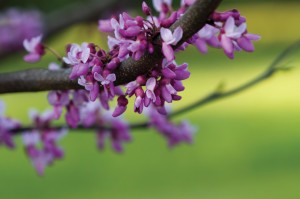 In Virginia, the flowering dogwood tree can get more than its fair share of the limelight. Its bloom is so beloved it was named the state flower in 1918. Almost a century later, the dogwood flower adorns license plates, roadway signs and bumper stickers across the Commonwealth. But there’s another native tree that deserves to see its name in lights. Gardeners who want to add an ornamental to their landscape this spring should look no further than the eastern redbud.
In Virginia, the flowering dogwood tree can get more than its fair share of the limelight. Its bloom is so beloved it was named the state flower in 1918. Almost a century later, the dogwood flower adorns license plates, roadway signs and bumper stickers across the Commonwealth. But there’s another native tree that deserves to see its name in lights. Gardeners who want to add an ornamental to their landscape this spring should look no further than the eastern redbud.
Jim Monroe of Roanoke’s Greenbrier Nurseries is a fan of the redbud. “I tell people they’re going to have a much greater chance of success with a redbud, as compared to a dogwood,” says Monroe. He likes dogwoods, but says they have some inherent flaws—susceptibility to fungal disease and stem bores are two—that can keep gardeners from being successful with them.
There are several different cultivars of redbud—all of which are members of “Fabaceae,” or the pea family. The eastern redbud (Cercis cannidensus L.) grows in the eastern United States and lower Great Plains, and does particularly well in Virginia’s soil. In the Midwest, Texas and Oklahoma redbuds are prolific, and there’s a western redbud that’s native to the western United States. Imported varieties, such as the Chinese redbud and the Afghan redbud, are non-native to the U.S. but popular cultivars too.
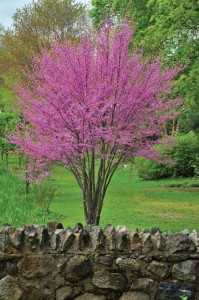 The eastern redbud, like the dogwood, is a harbinger of spring. Its flowers—small and pinkish-red in color—bloom early, beginning in March, and long before its leaves come in. Early bloomers, or pollinators, are especially important to insects and birds that have survived a long winter and need to feast on the season’s first flowers.
The eastern redbud, like the dogwood, is a harbinger of spring. Its flowers—small and pinkish-red in color—bloom early, beginning in March, and long before its leaves come in. Early bloomers, or pollinators, are especially important to insects and birds that have survived a long winter and need to feast on the season’s first flowers.
While the dogwood’s flowers bloom in sporadic clusters along its branches, the redbud’s flowers cover nearly every inch of its limbs, extending to its trunk and giving the tree the appearance of having been dipped in a pot of pink paint. For gardeners who like to have some color in their yard throughout the spring, a redbud can provide weeks of coverage while other trees, shrubs and plants ready themselves for their big debuts.
After the redbud blooms, small seed pods come in. Native Americans used to harvest the redbud’s flat, green seed pods as well as its flowers—both of which are high in vitamin C—to eat. They made use of the tree’s bark, too, concocting teas and astringents to treat whooping cough, fever, congestion and stomach problems.
The eastern redbud’s nectar is a favorite of hummingbirds and its pollen attracts honeybees. Squirrels go for its flowers, bark and seed pods, and whitetail deer snack on its foliage. While some gardeners aren’t fans of the tree’s seed pods, it may be a reassurance to know bobwhite quail and songbirds love them.
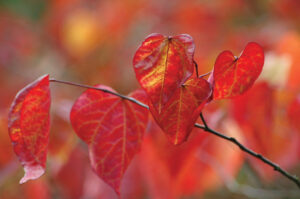 Only after the seed pods are in do the redbud’s leaves follow. Small and heart-shaped, the leaves are a dull, dark green that turn yellow in autumn.
Only after the seed pods are in do the redbud’s leaves follow. Small and heart-shaped, the leaves are a dull, dark green that turn yellow in autumn.
The eastern redbud can grow just about anywhere, which makes the tree a popular choice for novice gardeners who are afraid of getting something wrong. In the wild, redbuds tend to grow in the partial shade of the forest’s tree line, but it’s their ability to thrive in both full sun and full shade that makes them so versatile.
“The redbud is a drought-tolerant tree once it’s established,” says Monroe. He advises giving the redbud about five gallons of water per week for its first year. After that, the tree should be able to get by on rainwater.
Unlike comparable non-native ornamentals, such as the Bradford pear or crape myrtle, the redbud doesn’t require much in the way of pruning either.
“If you want to lightly prune, you can do it any time of the year,” says Monroe. “But if you work with a landscape designer and choose the proper tree for the space, you can eliminate the need to prune.”
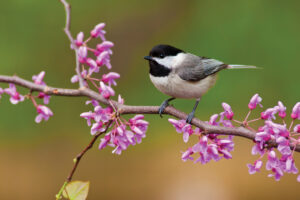 A redbud that isn’t pruned will eventually grow to be about 25 feet tall, with a 25- to 35-foot spread of foliage. Understory trees like the redbud look great framing a house because their shorter stature accents the roofline without dwarfing it. Horticulturists recommend planting flowering understory trees like the redbud in clusters. When they bloom, it’s as if someone graffitied the landscape with a very big brush.
A redbud that isn’t pruned will eventually grow to be about 25 feet tall, with a 25- to 35-foot spread of foliage. Understory trees like the redbud look great framing a house because their shorter stature accents the roofline without dwarfing it. Horticulturists recommend planting flowering understory trees like the redbud in clusters. When they bloom, it’s as if someone graffitied the landscape with a very big brush.
Water and pruning aren’t the only things homeowners can go easy on when it comes to planting and nurturing redbuds. Nurseries used to always advise gardeners to amend their soil with nutrient-rich potting soil and fertilizers, but some horticulturalists now say it may not be unnecessary. Eventually, all plants must adapt to their environment, and there’s evidence that the sooner this happens, the better.
“The redbud is a very resilient tree,” says Monroe. “It’s less fastidious about having a specific kind of soil. It’s a tree that can do well, even when your soil is rocky or dry.”
Despite that resiliency, Monroe warns homeowners to be careful planting any tree directly in the subsoil that is often used to backfill the foundations of new-construction homes. It lacks the nutrients found in native soil.
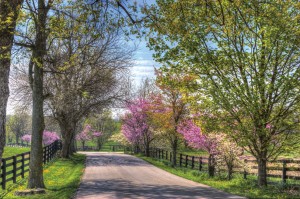 Because the redbud is so low-maintenance, there’s almost no wrong time to plant one. Monroe tells people that as long as the ground’s not frozen, they can plant anytime.
Because the redbud is so low-maintenance, there’s almost no wrong time to plant one. Monroe tells people that as long as the ground’s not frozen, they can plant anytime.
There’s no debating that a dogwood will outlive an eastern redbud. The average dogwood lives 80 years compared to a redbud’s 30-year lifespan. But the redbud’s blooms are so distinctive, it’s worth considering the tree as a complement to the dogwood, if not an alternative. In the past 10 years, there’s been an explosion of new redbud cultivars from which to choose. At most nurseries, shoppers can expect to spend about $125 for a six- or seven-foot tall tree.
Redbud or dogwood, it’s important to remember that native trees, shrubs and plants matter. Choosing a native tree guarantees a habitat for local wildlife, reduces the likelihood of introducing a non-native invasive plant into the landscape, and requires less maintenance and water usage. And more and more homeowners are tuning into these benefits. “The interest in native plants is high,” says Monroe. “With native plants, you’re supporting ecology and getting a landscape that’s more natural.”
Dogwood, Ecology, Greenbrier Nurseriy, Pruning Trees, Red Buds, Wildlife Habitat






